In The Demon-Haunted World, Carl Sagan explains how science works and why skepticism and critical thinking are important. The book is probably more relevant today than it was when it was published in 1995. With the internet at the center of many of our lives and social media allowing everyone to publish and share information, it is critical that we are able to evaluate what we see, hear, and read.
With a lot of non-fiction books, I feel that they are longer than necessary. After about 70% it often feels like the author repeats themselves or like there are too many examples to illustrate a concept.
The Demon-Haunted World is the opposite. It starts a bit slow for me. That’s not surprising as the book aims to explain science and critical thinking for someone with no prior knowledge of either.
The subjects that Sagan touches on are very broad. He details the injustices of the witch trials and talks about people who think they have been abducted by aliens. The parallels that can be drawn between them are interesting.
There are also people, especially in the US, who believe that aliens live among us and that the government knows this but is covering it up. Perhaps that explains a thing or two about the “situation” in the White House today. On the other hand, if there are aliens who are smart enough to travel through galaxies I don’t see how they would let Trump happen. Or, if they couldn’t stop it I assume they have buggered off to their own worlds again. Who would stay for this car crash if they didn’t have to?
Most people who claim to remember things that didn’t happen are genuine. They believe that they were kidnapped by aliens. This is not as crazy as it sounds. Our memories are incredibly unreliable. It’s easy to make someone “remember” something that never happened. A remarkable example is the fact that Reagan during his presidency regularly told stories from his past that turned out to be scenes from films that made a strong impression on him. It’s also quite common to remember a memory from someone close to you as your own. Our minds are fascinating but unreliable.
To support our fallible brains Sagan has included a “baloney detection kit” in the book. Here is my top 5 from the kit:
- Look for independent confirmation of the “facts”
- Arguments from authority don’t carry more weight than other arguments. Arguments from experts do carry more weight but are still open to scrutiny
- Try not to get overly attached to your own hypothesis or opinion. Keep an open mind for new and better ideas and hypothesis (but if you open your mind too much your brain might fall out)
- If there’s a chain of argument, every link in the chain needs to hold up to scrutiny, not just some of them
- Ockham’s razor: if two hypotheses explain the data equally well choose the simplest one that introduces the least amount of new assumptions
What I like about Sagan and this book is his focus on how to communicate. By “waxing superior and contemptuous” about skepticism and science you are unlikely to convince anyone. Skepticism can come across as arrogant and heartless and it doesn’t have to be either.
We all cherish our beliefs and when someone challenges them this can feel like a personal assault. Whether your beliefs are related to aliens, witches, religion, or science doesn’t matter. Sagan asks “to temper our criticism with kindness”. To apply finesse when we share our believes and opinions. We all have different backgrounds, which means that we come to these discussions with different toolkits and baselines.
The way Sagan talks about curiosity, kindness, and communication inspires me. It makes me excited about communicating complex things in simple terms. About making people feel safe but also interested in learning and gaining knowledge.
I’m not a scientist myself. I don’t naturally ask a lot of questions. Even in a fairly simple conversation, I have to remind myself to ask questions. I’m not sure why. Part of it has to do with the need to process new information before I feel comfortable enough to voice my opinion about it. Maybe another reason is that for several years while in school the safest option was to be invisible and not draw attention to myself.
The Demon-Haunted world makes me want to be more naturally curious, but it mostly makes me long to be a writer or a journalist. I would love to try and share science, skepticism, and critical thinking in a way that allows people with all sorts of different believes to open their minds a little bit. I might figure out how and where to do this eventually. Until then I encourage you to read The Demon-Haunted World. There is something in it for everyone and Carl Sagan made communicating about science an art form.



Mirjam, I have actually read this book and have it in my basement library.
(wall to wall books in my basement. LOL )
As always, you did a wonderful review and I think I will be re-reading this book again.
Thank you for your review.
Be well and be safe. 🙂
LikeLiked by 1 person
Oh, I’m experiencing some library envy here 😉. What are you reading at the moment?
Stay safe!
LikeLike
Mirjam, lol on the library envy!
On my nightstand at the present time I have ,The plot Against America by Philip Roth, Dogs Days by Jon Katz, When Elephants Weep by Jeffrey Moussaaieff Masson, The Cat Who’ll Live Forever by Peter Gethers , Hannah’s Gift by Maria Housden . I have read all of these books before but am enjoying them just as much the 2nd time around.
Take care ! 🙂
LikeLiked by 1 person
Oh wow, Margie! That’s a lot of books. I’ve read none of them, so I will check them out.
I generally read two books at the same time (one fiction and one non-fiction). Occasionally three, but only when I get impatient with one of them.
LikeLiked by 1 person
Mirjam, I have so many books, so little time! 🙂
LikeLiked by 1 person
😄
We need more reading time!
LikeLike
Pingback: Top 15 Most Impactful Books That I Read In 2020 | Kalliope's Journey